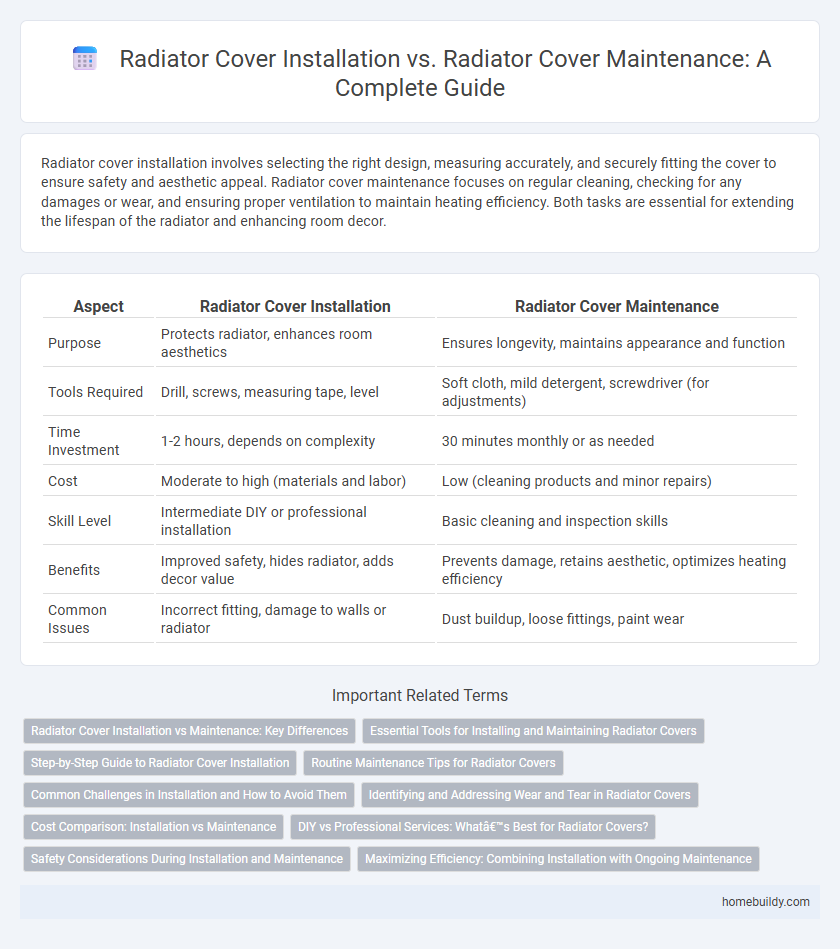Radiator cover installation involves selecting the right design, measuring accurately, and securely fitting the cover to ensure safety and aesthetic appeal. Radiator cover maintenance focuses on regular cleaning, checking for any damages or wear, and ensuring proper ventilation to maintain heating efficiency. Both tasks are essential for extending the lifespan of the radiator and enhancing room decor.
Table of Comparison
| Aspect | Radiator Cover Installation | Radiator Cover Maintenance |
|---|---|---|
| Purpose | Protects radiator, enhances room aesthetics | Ensures longevity, maintains appearance and function |
| Tools Required | Drill, screws, measuring tape, level | Soft cloth, mild detergent, screwdriver (for adjustments) |
| Time Investment | 1-2 hours, depends on complexity | 30 minutes monthly or as needed |
| Cost | Moderate to high (materials and labor) | Low (cleaning products and minor repairs) |
| Skill Level | Intermediate DIY or professional installation | Basic cleaning and inspection skills |
| Benefits | Improved safety, hides radiator, adds decor value | Prevents damage, retains aesthetic, optimizes heating efficiency |
| Common Issues | Incorrect fitting, damage to walls or radiator | Dust buildup, loose fittings, paint wear |
Radiator Cover Installation vs Maintenance: Key Differences
Radiator cover installation involves selecting the right size and style, securing the cover properly, and ensuring adequate ventilation to maintain efficient heat flow. In contrast, radiator cover maintenance focuses on regular cleaning, inspecting for damage or wear, and repainting or refinishing to preserve appearance and functionality. Understanding these distinctions helps prolong radiator lifespan and enhances home safety and aesthetics.
Essential Tools for Installing and Maintaining Radiator Covers
Essential tools for installing radiator covers include a drill, screws, a screwdriver, a tape measure, and a level to ensure precise fitting and secure attachment. For maintaining radiator covers, tools such as a soft brush, vacuum cleaner with brush attachment, microfiber cloth, and mild cleaning agents are crucial to prevent dust buildup and preserve the cover's finish. Proper use of these tools enhances both the durability and aesthetic appeal of radiator covers.
Step-by-Step Guide to Radiator Cover Installation
Follow a step-by-step guide to radiator cover installation by measuring the radiator dimensions accurately to ensure a perfect fit. Assemble the cover components securely with appropriate tools like screws and brackets, prioritizing safety and stability. Regular maintenance after installation involves dusting and checking for loose fittings, but the initial installation process demands precise alignment and secure fixing to optimize both aesthetics and radiator efficiency.
Routine Maintenance Tips for Radiator Covers
Routine maintenance for radiator covers includes regular dusting and wiping with a damp cloth to prevent dust buildup that can impede heat flow. Inspecting the cover for any signs of wear, loose screws, or damage ensures continued safety and functionality. Periodic cleaning of vents or grills maintains optimal airflow and maximizes heating efficiency.
Common Challenges in Installation and How to Avoid Them
Radiator cover installation often presents challenges such as improper measurements, which can lead to poor fit and reduced heat circulation, and difficulty securing the cover without damaging the radiator or surrounding walls. To avoid these issues, precise measuring using a tape measure and proper tools like anchors and screws designed for the wall type are essential. Ensuring adequate ventilation space and consulting manufacturer guidelines can prevent overheating and maintain radiator efficiency.
Identifying and Addressing Wear and Tear in Radiator Covers
Identifying and addressing wear and tear in radiator covers is essential for maintaining their aesthetic appeal and functionality. During installation, selecting durable materials like metal or high-quality wood reduces the likelihood of damage from heat and moisture. Regular maintenance involves inspecting for cracks, peeling paint, or warped panels, followed by timely repairs or refinishing to prolong the radiator cover's lifespan.
Cost Comparison: Installation vs Maintenance
Radiator cover installation typically involves a one-time cost ranging from $100 to $300, depending on materials and customization, whereas maintenance costs are generally lower but recurring, averaging $20 to $50 annually for cleaning and minor repairs. Installation enhances safety and aesthetics immediately, reducing the need for frequent upkeep, while maintenance ensures longevity and functionality of the cover over time. Comparing total expenses over five years, installation presents a higher upfront investment but can minimize ongoing maintenance costs, leading to potential savings in the long term.
DIY vs Professional Services: What’s Best for Radiator Covers?
Radiator cover installation often requires precise measurements and structural adjustments, making professional services ideal for ensuring safety and proper fit, while DIY methods may save costs but risk errors affecting radiator efficiency. Maintenance of radiator covers, such as cleaning and minor repairs, is typically manageable for homeowners, promoting longevity and aesthetics without specialized tools. Balancing initial professional installation with regular DIY upkeep offers an optimal approach for maintaining radiator covers effectively.
Safety Considerations During Installation and Maintenance
Radiator cover installation requires careful attention to secure fit and proper ventilation to prevent overheating and fire hazards, ensuring that sharp edges and heavy parts are handled with protective gloves and tools. During maintenance, regularly checking for blockages, corrosion, or loose fittings minimizes risks of heat buildup and potential burns. Both phases must prioritize fire safety standards and ensure the radiator cover remains stable to protect users from accidental contact with hot surfaces.
Maximizing Efficiency: Combining Installation with Ongoing Maintenance
Maximizing efficiency of radiator covers involves both precise installation and routine maintenance to ensure optimal heat distribution and energy savings. Proper installation secures the cover's fit, preventing heat loss, while regular cleaning and inspection maintain airflow and prevent dust buildup that can reduce performance. Combining these practices extends the lifespan of the radiator cover and enhances overall heating system efficiency.
Radiator cover installation vs radiator cover maintenance Infographic

 homebuildy.com
homebuildy.com